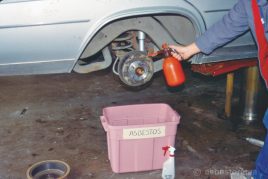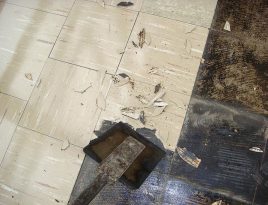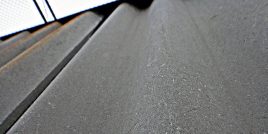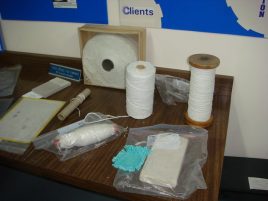Based on Your Reading:
Get Your Free Mesothelioma Guide

Find a Top Mesothelioma Doctor

Access Help Paying for Treatment

Asbestos-containing products are mainly used for construction and insulation, but the toxic mineral may also be found in many types of consumer goods. There are regulations for working on asbestos-containing materials in the U.S., but only certain asbestos products are banned.
Written by Daniel King • Edited By Walter Pacheco • Scientifically Reviewed By Dr. Jerald L. Cook
The Mesothelioma Center at Asbestos.com has provided patients and their loved ones the most updated and reliable information on mesothelioma and asbestos exposure since 2006.
Our team of Patient Advocates includes a medical doctor, a registered nurse, health services administrators, veterans, VA-accredited Claims Agents, an oncology patient navigator and hospice care expert. Their combined expertise means we help any mesothelioma patient or loved one through every step of their cancer journey.
More than 30 contributors, including mesothelioma doctors, survivors, health care professionals and other experts, have peer-reviewed our website and written unique research-driven articles to ensure you get the highest-quality medical and health information.
My family has only the highest compliment for the assistance and support that we received from The Mesothelioma Center. This is a staff of compassionate and knowledgeable individuals who respect what your family is experiencing and who go the extra mile to make an unfortunate diagnosis less stressful. Information and assistance were provided by The Mesothelioma Center at no cost to our family.LashawnMesothelioma patient’s daughter


King, D. (2024, March 20). Asbestos Products. Asbestos.com. Retrieved April 11, 2024, from https://www.asbestos.com/products/
King, Daniel. "Asbestos Products." Asbestos.com, 20 Mar 2024, https://www.asbestos.com/products/.
King, Daniel. "Asbestos Products." Asbestos.com. Last modified March 20, 2024. https://www.asbestos.com/products/.
American industries used many types of asbestos products from the late 1800s through the 1980s. Construction, manufacturing, power generation and chemical refining relied on asbestos products for decades.
Regulations enacted from the 1970s through the 1990s limited the use of asbestos. Lawsuits also discourage companies from continuing to use the mineral Asbestos products that are still commonly used in nations such as Russia, China, India and Mexico.
Many Americans wonder what products are sources of asbestos today. New asbestos products are not made in the U.S., but they may be imported from other countries. Imported roofing materials, joint compounds, gaskets and brake pads may contain asbestos.
According to a 2020 report by the U.S. Environmental Protection Agency, one industry imports raw chrysotile asbestos. Plans to ban that type of asbestos in the U.S. were finalized in March 2024. The ban allows companies 12 years to phase out the material from the manufacturing process. The chloralkali industry continues to import the mineral to make asbestos diaphragms. The report found unreasonable asbestos exposure risk for industrial and blue-collar workers.
It also can be found in oilfield brake blocks, aftermarket automotive brakes, linings and other vehicle friction products, sheet gaskets used in chemical production facilities and gaskets used in other industries.
The EPA also found a risk to consumers handling gaskets and aftermarket auto brakes and linings. Asbestos has been recently detected in contaminated talc products, including baby powder and children’s makeup.
Some old asbestos materials remain in place, including attic insulation or floor tiles in older homes. Some uses of asbestos remain active today, such as old asbestos pipes used for plumbing and laboratory equipment at universities around the country. Asbestos has been used in building materials such as adhesives, cement, roofing shingles and more.
Asbestos is a versatile mineral. Countless construction materials contained asbestos. Roofing shingles, ceiling and floor tiles and cement products had asbestos. It was also used in friction products, heat-resistant fabrics, packaging, gaskets and coatings.
Construction workers were exposed when building homes. Plumbers are exposed to asbestos pipes and insulation. Electricians are exposed while repairing electrical panels and other equipment. Professional auto mechanics are exposed when changing brakes and clutches. Do-it-yourselfers who perform repairs on older homes are at risk. Home auto mechanics handling aftermarket brake pads and clutch linings are also at risk of asbestos exposure.
Some of the most common asbestos products:

Brake pads, clutches, hood liners, gaskets and valves contained asbestos.

Flooring, ceiling and roofing tiles were commonly made with asbestos. The adhesive used to lay down flooring tiles has also been a source of exposure.

Asbestos fibers provided strength without adding much weight to cement. Its insulating and fire-resistant properties also made it ideal for cement.

Asbestos was used in the production of cloths and garments for its resistance to heat and corrosive elements. Some of the most common textiles included blankets, firefighter suits and rope.
The U.S. EPA’s 2020 risk evaluation found an unreasonable risk to the health of chloralkai workers who handle raw asbestos to make diaphragms. The asbestos diaphragms work as a filter to produce chlorine and sodium hydroxide. Asbestos reportedly does not end up in the final products, so the agency did not find a threat to consumers.
In February 2021, the U.S. Geological Survey reported a 30% increase in raw chrysotile asbestos importation for the previous year. These imports supported the chloralkai industry.
The use of asbestos-containing products stretched across a number of industries. Most of the products could be categorized as either construction or automotive materials.
Consumers, homeowners and do-it-yourselfers have been exposed to asbestos in consumer goods and home building materials. Current DIY projects in older homes present an exposure risk to homeowners today. Do-it-yourselfers who installed their own insulation and flooring before the 1990s faced a high risk of dangerous asbestos exposure.
Consumers of makeup are at risk of exposure to asbestos through contaminated talc products. Unfortunately, asbestos has been detected in children’s makeup in recent years. It has also appeared in children’s toys, including crayons, clay and a fingerprint kit.
Get Your Free Mesothelioma Guide

Find a Top Mesothelioma Doctor

Access Help Paying for Treatment

Asbestos was used for its ability to strengthen and fireproof materials, including concrete, bricks, fireplace cement, pipes and insulation. Although the use of asbestos has been largely phased out since the 1980s, it can still be found in products such as gaskets and brake pads.
Until the 1800s, people mainly used asbestos to make fireproof cloth in small amounts. Then, during the Industrial Revolution, great demand arose for a material that could insulate steam engines. At the same time, the technology was developed to easily mine asbestos and combine it with other materials.
During the 20th century, demand for asbestos products was propelled further by the shipbuilding efforts of World War II and the postwar building boom. Many veterans were exposed to asbestos during both their military service and their civilian careers.
By the 1970s, lawsuits were holding asbestos manufacturers liable for the diseases their products caused. Workers who developed mesothelioma, lung cancer and asbestosis were suing for compensation to cover medical costs and lost wages. Unfortunately, doctors are still searching for a cure for every type of asbestos-related disease.
Asbestos has unique chemical and physical properties that make it strong and resistant to heat and chemical reaction. Its chemical composition makes it less likely to react with other compounds, and the space between its fibers reduces conduction of heat, making it resistant to fire.
In March 2024, the Biden administration finalized a U.S. ban on chrysotile asbestos. The mineral also known as white asbestos, continues to be imported into the U.S. for use in the chloralkali industry. The ban allows companies to continue using the material during a phase-out period of up to 12 years. The ban doesn’t apply to all types of asbestos.
Currently, several asbestos products are banned in the U.S. through the Clean Air Act, the Consumer Product Safety Act and regulations enacted by the U.S. Food and Drug Administration and the U.S. Environmental Protection Agency, known as the EPA.
The EPA is reviewing legacy uses of asbestos to assess current risk to workers and the general public. It conducted a review of current asbestos uses and issued a final rule in 2019 prohibiting new asbestos products from entering the market without a review. This applies to once-common products such as asbestos plastic, asbestos cement and vinyl asbestos tile.
The agency attempted to issue a ban on all asbestos products in 1989, but the U.S. Court of Appeals for the Fifth Circuit overturned the ban in 1991 under pressure from industry lobbyists. The EPA was able to ban six asbestos products at the time, and the ruling did not reverse previously banned asbestos materials. Because of this, certain asbestos-containing products, such as gaskets and brake pads, are still sold in America.
By law, these products are not required to carry a warning label if they are less than 1% asbestos or if they will not release asbestos fibers during any reasonably foreseeable use.
Though asbestos remains legal in the U.S., regulatory organizations control its use and manage its removal from older buildings.

Asbestos in homes is commonly present in the following products:
Examples of materials that contain asbestos in schools include:
Unfortunately, some asbestos-containing materials, such as brake pads and gaskets, are still being sold in the United States. Manufacturers are not required to warn consumers of asbestos content if the product contains less than 1% asbestos.
Common sources of asbestos in home goods include:
Examples of talc products containing asbestos in makeup and toys are:
Your web browser is no longer supported by Microsoft. Update your browser for more security, speed and compatibility.
If you are looking for mesothelioma support, please contact our Patient Advocates at (855) 404-4592
